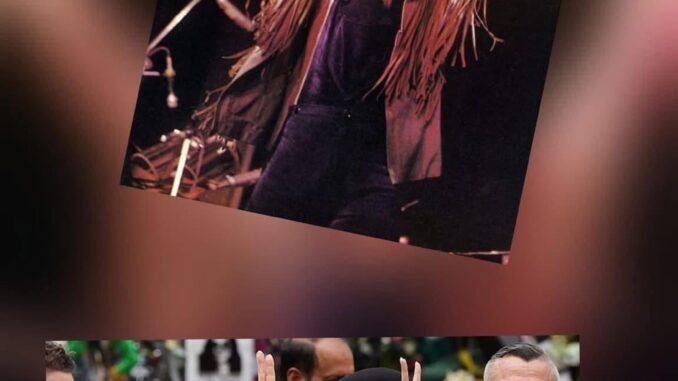
The Last Tour
The sky over Birmingham was overcast, heavy with clouds and memory. A soft drizzle slicked the roads as the hearse carrying Ozzy Osbourne — the Prince of Darkness — began its solemn procession through the city he called home. Lined with deep purple flowers that draped like velvet over the casket inside, the hearse was flanked by six sleek black Mercedes funeral cars. Police motorcycle riders led and followed the cortege, their blue lights flashing like slow, respectful applause.
The streets, usually bustling with the sound of everyday life, had fallen eerily silent. Instead, there was a reverent hush that blanketed the city, broken only by the occasional soft sob, the low hum of idling engines, or the quiet chants of fans singing “Iron Man” under their breath.
The procession wound through poignant locations — a curated, sacred map of Ozzy’s journey. It passed by his modest childhood home, where a young, troublemaking boy named John Michael Osbourne first dreamed of music. Neighbors and lifelong locals stood with bowed heads, some wiping away tears, others raising devil horns skyward in tribute. Old men who remembered him from the streets, and young fans born decades after his first hit, stood side by side, sharing the weight of loss.
Then came Broad Street, and with it, a swell of emotion that could be felt like thunder beneath the skin. The hearse slowed as it approached the Black Sabbath bench, a now-historic landmark where thousands of fans had gathered in recent days, leaving behind a sea of tributes — candles, vinyl records, hand-drawn portraits, scrawled notes, and of course, endless bouquets of purple flowers.
This was more than a tribute. It was a homecoming. A farewell tour with no encore.
From one of the black funeral cars, Sharon Osbourne stepped out, joined by their three children — Aimee, Jack, and Kelly. The four of them stood still for a moment, absorbing the sight in front of them. The crowd stretched as far as the eye could see. Fans filled the street, the pavement, the steps of nearby buildings, holding signs that read “Thank You Ozzy”, “No More Tears”, and “Long Live the Prince.”
There were people dressed in vintage Black Sabbath shirts, teenagers with freshly inked tattoos of Ozzy lyrics, and elderly fans holding their original 1970 vinyl copies of Paranoid. Some held hands. Some stood alone. All were connected by the same unshakable truth — Ozzy had not just made music. He had made an impact. He had made family out of strangers.
Sharon, in a tailored black coat, her hair pinned back, looked out over the crowd. Her face was pale but strong. She had always been his warrior — manager, partner, protector, wife. More than forty years of marriage had not dulled the fire between them. Now, as the world grieved, she held her ground with the quiet power that had always defined her.
Then, as the silence deepened and phones came down, she raised her arms slowly — and made the peace sign with both hands.
It was a simple gesture. But it struck like lightning.
The crowd erupted — not in applause, but in a swell of raw emotion. People sobbed harder. Others raised their own peace signs in reply. Some shouted, “We love you, Ozzy!” while others simply whispered, “Thank you.”
It was a move Ozzy had made a thousand times from stages around the world — that double peace sign, fingers outstretched, arms raised like wings. A gesture of unity. Of rebellion. Of love. Sharon’s act wasn’t just a tribute; it was a message: He is still here. In all of us.
Jack and Aimee stood beside her, each in dark suits, their eyes glassy. Kelly, visibly heartbroken, leaned into her mother, holding her hand tightly. All three had grown up in the chaos and glow of their father’s world, yet here they were — dignified, grounded, and full of love.
The hearse continued past them slowly, like a ship leaving port, and the crowd parted in respectful silence to let it through. Some reached out as if to touch the vehicle, others simply bowed their heads. The car’s windows, slightly tinted, revealed the soft glow of the flowers inside — rich purple against polished wood. The final stage light for a man who had lived his life in the spotlight.
As the procession moved on, fans trailed it on foot for blocks, unwilling to let go. The police officers allowed the slow march to continue, recognizing the significance of the moment. For many, this was their way of saying goodbye — not with headlines or speeches, but with presence.
Eventually, the cortege turned toward its final destination — a private service for family and close friends. But the public farewell had already happened. Birmingham had shown up in force. The fans, the streets, the landmarks — they had spoken louder than any eulogy ever could.
Back at the Black Sabbath bench, as the last echoes of the crowd faded, a lone guitarist began to play the opening riff to “Changes.” A few stopped to listen. Some sang along, tearfully. Others just sat quietly on the bench, next to the statue of the band that changed music forever.
Sharon and her children watched from a distance, unmoving. There was nothing more to say.
Ozzy Osbourne was gone. But his legend, his love, his music — they would echo forever, down every street, in every song, in every peace sign raised high under a cloudy English sky.
Leave a Reply